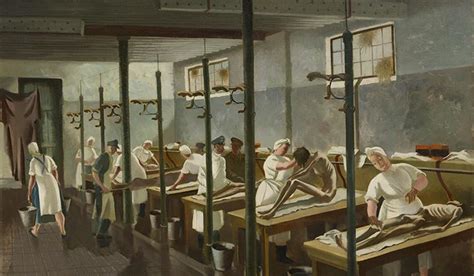
Dir: Margy Kinmonth | UK Doc 87′
One of the many tragedies of war is the annihilation of culture and identity.
War Paint – Women At War shines a light on female war artists who champion their perspective on conflict, asking the question ‘when it’s life or death, what do women see that men don’t?’.
Full of fascinating details this informative film features artists Rachel Whiteread, Zhanna Kadyrova, Maggi Hambling, Assil Diab, Laura Knight, Marcelle Hanselaar, Cornelia Parker, Maya Lin and Lee Miller.
War Paint is the final part of her war trilogy that began with Eric Ravilious – Drawn to War and War Art with Eddie Redmayne, Margy Kinmonth shines a light on the pioneering role of women war artists on the front lines round the world, traditionally a male domain, championing the female perspective on conflict through art, and asking: “when it’s life death, what do women see that men don’t?”.
Linda Kitson is best known as being the first woman to accompany troops into war as an official war artist on the Falklands conflict. The arena of war is frightening, but Kitson rose the task producing hundreds of drawings at speed to provide a running story of the front line. The ferocious wind and rain made it almost impossible, although freedom was guaranteed in her subject matter. Kitson wishes she’d been less reticent and more bold in portraying the reality of the violence and mayhem.
Seventy five million people died in WWII. Well known writer Penelope lively talks of her aunt, Rachel Reckitt, who portrayed the post WWII landscape in London. Rachel says it in graphic black and white with bold images of urban poverty in tribute to thousands made homeless by the bombing and violence.
English Impressionist Dame Laura Knight (1877-1970) was invited by the Royal Academy to capture a woman’s view of the Second World War. Her art shows how women were employed in the war effort in factories, and driving ambulances, one of her paintings won a top prize at the RA during the era, and lived on in the public memory. Later she was commissioned by the UK government to create commemorative paintings during three months during the Nuremberg Trials.
Meanwhile over at Bletchley Park many women were involved in bringing WWII to a quick end, and their vital work was also recorded. Hidden away in attic, Olga Lehmann’s son discovered his mother’s effective portraits of wartime London, Suffolk artist Charlotte Johnstone’s grandmother even travelled to Germany where she painted ambulances in Belsen and hospitals with plump German nurses treating emaciated victims of the Holocaust.
Also during the Second World War, American photographer Lee Miller took many thousands of images. Women were involved in active service and she captured the adrenaline of those operating the ATS searchlights when many were killed as they endured 57 nights of bombardment. Miller, who started her career at Vogue Magazine in New York, also took pictures of fashion on the war torn streets of London during the Blitz.
Artist Dame Rachel Whiteread was the first woman to win the Turner Prize by capturing negative space with her plaster works. In Vienna Austria she was chosen to commemorate the Jewish tragedy during the Second World War. She came up with the idea of an installation that features a series of books with their spines inwards as a tribute to the Holocaust.
Kinmont then ventures further afield to document more recent ways that women have raised the profile of social upheaval in their art. In 1979, women in Iran were forced under the veil, and their anger became ingrained and has been building up for over 40 years. In the streets of Tehran morality police continue to silence any dissent. But the image can speak clearly and globally. Artist Shirin Neshrat has fought against the system with great delicacy. Her work contrasts guns and violence with a sense of erotic rebellion, with sensual depictions of texts and partly veiled women becoming her major theme: A woman who can create can also kill.
Dutch artist, Marcelle Hanselaar has specialised in raising the profile of rape as a destructive force in wartime. Rape is very much a divisive weapon of war that has a cascade effect on future generations. She first encountered the impact of rape during Vietnam amongst the American soldiers. But also points out that even as far back at the eleventh century, nuns were stitching images of rape as a weapon of war in the Bayeux Tapestry. Words are powerful but photography and images can make these crimes more seen on a global level .
Back in England Fiona Banner’s work depicts how military hardware and flying machines are a constant reminder of war even today. Her video of a fly past with planes in a formation that spells ‘DISARM’ has been particularly effective in this endeavour. Sculptor Maggie Hambling has used the human head as focus for her war art.
Apart from her installation art, Cornelia Parker has been make films with her iPhone that engage with social issues since 2007. In 2015, she was commissioned to commemorate the centenary of the First World War with a film called War Machine. It shows the production of Remembrance Day poppies in a slow reveal, the mechanical process reminiscent of old film reels. Today poppies go out to eighty countries round the world.
But perhaps the loveliest most moving and intimate work of war art is a quilt stitched by women who wanted to sent out a message of survival from Changi prison camp, Singapore in 1942. The beauty of art is to remind us all of our humanity. @MeredithTaylor
In UK-Ireland cinemas on Friday, March 28 | It is a Sky Original documentary that will also play on the Sky Arts channel later in 2025.